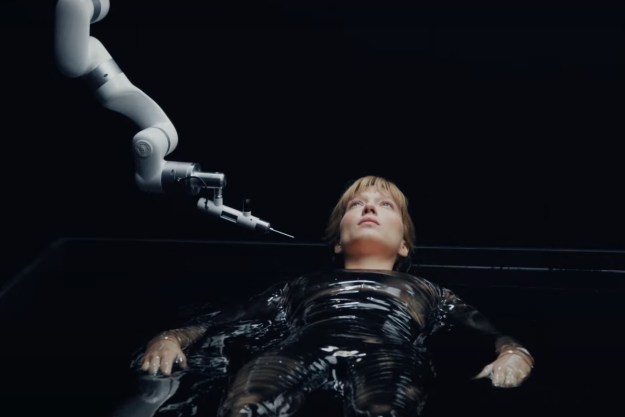
“The full galaxy-brain ambition of The Beast could not be anticipated.”
- Wildly ambitious
- Deeply unnerving
- Two strong performances
- Some awkward stretches
For Bertrand Bonello, movies are like rubber bands: They’re meant to be stretched as far as they’ll go. The Beast, the French writer-director’s latest, spans eras, continents, languages, and genres. It is, at minimum, three movies in one, with enough preoccupations for many more still. Bonello loves to collapse time and space. His rapturous House of Pleasures used anachronistic pop and a parting, divisive flash-forward to connect one century’s sex work to another’s, while his Zombi Child possessed a modern Parisian coming-of-age drama with the spirit of midcentury Haitian horror. Conceptually speaking, those were but preludes to the audacious pastiche he’s made this time. The full galaxy-brain ambition of The Beast could not be anticipated.
As it turns out, an inability to anticipate is what Bonello is driving at here, at least in part. Unease about a future that is unknown certainly haunts Gabrielle, his chronologically trifurcated heroine, played by French movie star and former Bond girl Léa Seydoux. “Can you get scared by something that’s not actually here?” a filmmaker asks her during an acting audition. Standing against a wall fully draped in green screen, he’s talking about the ability to convincingly react to nothing — an all-too-necessary skillset for performers of the 21st century. For Gabrielle, this is not a big ask. She has, after all, spent multiple lifetimes gripped by fear of something that’s not actually there. That’s the beast of the title, though psychologists know it by a different name.
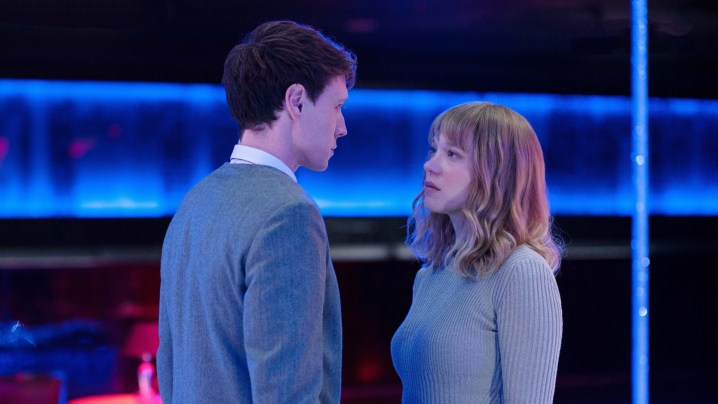
The movie opens on a soundstage, a backdrop of green, in what turns out to be a flashback of sorts. The present tense of The Beast is the future — specifically, a serenely dystopian 2044 controlled by AI and defined by a willful movement toward dimming emotion. Bonello’s conception of this bleak world is suggestively sparse: bare rooms shrouded in darkness, eerily depopulated streets, fashion and interior design not easily identified by decade. Less can be more when you’re trying to envision tomorrow on a budget; as a bonus, the black-box minimalism and lack of technological detail guarantee that The Beast won’t look hopelessly outdated six months from now.
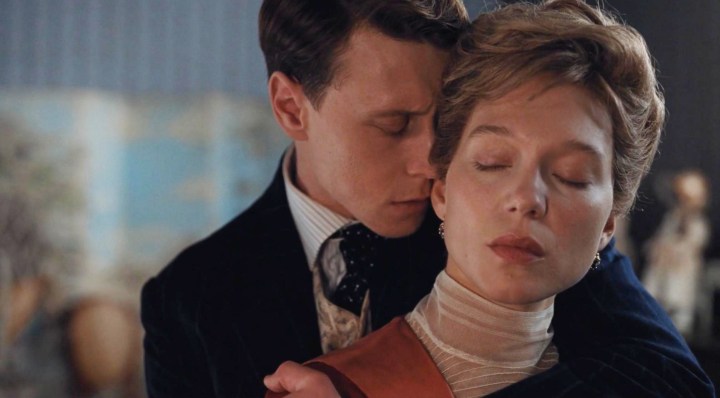
Guided by a disembodied computer overlord voiced by fellow filmmaker Xavier Dolan — an element that recalls Alphaville, a gold standard for resourcefully making now feel like later — Gabrielle submits to “purification.” This faintly Lacuna Inc-like therapy allows patients to access memories of past lives to scrub their very DNA of bad feelings. Through the process, Gabrielle discovers her secret connection to a handsome stranger she’s just met, Louis (1917’s George MacKay, in a part originally intended for Bonello’s late St. Laurent star Gaspard Ulliel). It turns out the two really met in another lifetime, in the France of 1910, when she was a married musician and he a dashing suitor. Their tentative courtship, creeping around the edges of indiscretion, allows Bonello to do his own version of Edith Wharton — a miniature costume drama elegantly shot on 35mm.
The dialogue during these terrific scenes alternates between French and English, sometimes almost as a means of inflection, reflecting subtle shifts in the seductive charge between the two. Some of it is borrowed from the unlikely source material: the 1903 Henry James novella The Beast in the Jungle, about a man caught in a self-fulfilling prophecy, so blinded by his certainty that misfortune awaits him that he fails to really live (which is, of course, the misfortune he fears). To say that this is a loose adaptation would be to put it lightly; more than just flipping the gender of the afflicted character, Bonello expands the story outward into a curious science fiction triptych. But its tragedy remains visible through the metaphysical layers. Much of it rests on Seydoux, the rare modern movie star with a timeless glamour, equally at home in an opera house of the early 1900s and a bumping nightclub of the debased 2010s.
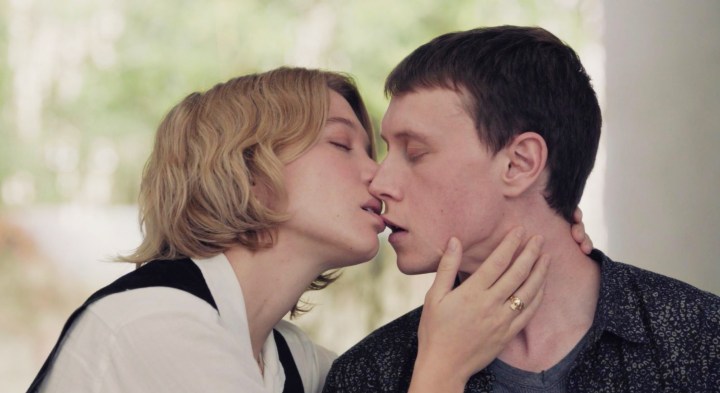
Speaking of which, The Beast eventually leaps into the Los Angeles of 2014, when Gabrielle is now an aspiring actress. Louis, meanwhile, has been reborn as an embittered virgin; his resentment is like an echo of the rejection he experienced a century earlier across the ocean. Bonello models this new version of the character on Elliot Rodger, the mass shooter who killed six people during a rampage near the University of California, Santa Barbara. MacKay, delivering a close imitation of that real-life killer’s misogynistic YouTube musings, chillingly taps into the entitlement and self-pity of incel martyrdom. What’s spooky-good about the performance is how you can still see glimmers of the romantic MacKay plays in the turn-of-the-century scenes. He creates a continuity of character across two very different specimens of blue-balls bachelorhood.
Marked by a few stilted bit performances and a hypnotically repetitive rhythm, this near-contemporary stretch of the movie — a trance stalker thriller in the City of Angels — is at once awkward and nightmarish. The two qualities are perhaps related, even inextricable. Does it say something about the unreal nature of modern life that the scenes closest to “present day” are the least convincing? Bonello’s barely period-piece vision of a Hollywood of casting calls, callous nightlife, and video-call psychics suggests a sentence translated from English to French and then back again. While so much fiction paints the early 20th century as an age of repression, Bonello intriguingly upends convention by depicting the world of the past as more emotionally open than the present.
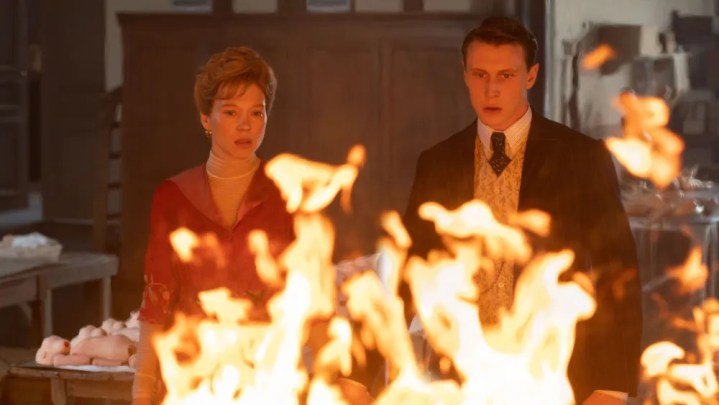
Just as motifs repeat across the film’s timelines — dolls, pigeons, and fortune tellers make multiple appearances — there’s a déjà vu quality to much of The Beast itself. Befitting its laptop-age flourishes, it sometimes suggests a gonzo supercut, as if Bonello were filtering past-lives reveries of the past like Cloud Atlas, The Fountain, and 2046 through the velvet dread of David Lynch. (The ending, when a waltz in a red room shatters into screaming distress, is deeply Twin Peaks-coded.) All the same, Bonello’s way with unnerving atmosphere is his own. The movie’s climax, a fated reunion of estranged kindred spirits that plays out in a vulnerable glass house on the edge of showbiz, is like a shuddering psychic aftershock of the director’s masterpiece, Nocturama. Here, as in that terrorists-in-Paris provocation, Bonello warps time, turning the suspenseful final scenes into a buffering, skipping glitch in the feed.
“It’s very inventive, but it’s hard to find the emotion in it,” someone says of a piece of music early on. For some, that may be true of The Beast, too: It’s easier to admire the structural gambit of the film — to marvel at the scope of its genre-blending, century-jumping architecture — than to be drawn into its melodrama. But maybe that’s just a reflection of the hesitancy at the heart of the story. After 150 years, will these two finally become one? Or are they destined to keep passing each other like ships in the night? For all Gabrielle’s odyssey of therapeutic remembrance recalls a library of reincarnation romances, Bonello’s real subject isn’t love but the ways we psychologically wall ourselves off from it. Passion fades with time. It’s our defense mechanisms and the anxieties undergirding them that are truly built to last.
The Beast opens in select theaters Friday, April 5. For more of A.A. Dowd’s writing, visit his Authory page.



